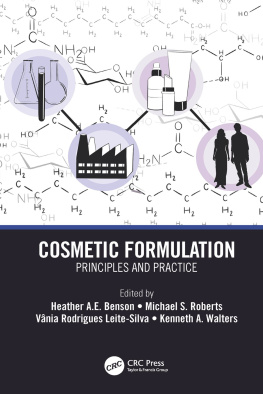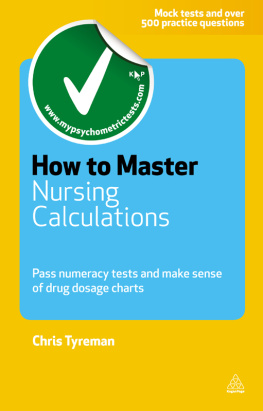Contents
Clive G. Wilson
R. Holm
Majella E. Lane and Nicola Parisi
Qonita Kurnia Anjani, Akmal Hidayat Bin Sabri, Stefan Henke and Ryan F. Donnelly
M. Cavinato
Marshall Whiteman
J. G. Clarke and A. P. Savage
M. L. D. Rayner and J. B. Phillips
Neel Desai, Laura E. McCoubrey, Christine M. Madla, Francesca K. H. Gavins and Mine Orlu
Patrick J. Crowley, Sharon M. Maglennon, Luigi G. Martini and David Templeton
D. Clapham
Kendal Pitt
Drug Discovery Series No. 2
Print ISBN: 978-1-83916-175-9
PDF ISBN: 978-1-83916-560-3
EPUB ISBN: 978-1-83916-561-0
Print ISSN: 2631-5246
Electronic ISSN: 2631-5254
A catalogue record for this book is available from the British Library
The Royal Society of Chemistry 2022
All rights reserved
Apart from fair dealing for the purposes of research for non-commercial purposes or for private study, criticism or review, as permitted under the Copyright, Designs and Patents Act 1988 and the Copyright and Related Rights Regulations 2003, this publication may not be reproduced, stored or transmitted, in any form or by any means, without the prior permission in writing of The Royal Society of Chemistry or the copyright owner, or in the case of reproduction in accordance with the terms of licences issued by the Copyright Licensing Agency in the UK, or in accordance with the terms of the licences issued by the appropriate Reproduction Rights Organization outside the UK. Enquiries concerning reproduction outside the terms stated here should be sent to The Royal Society of Chemistry at the address printed on this page.
Whilst this material has been produced with all due care, The Royal Society of Chemistry cannot be held responsible or liable for its accuracy and completeness, nor for any consequences arising from any errors or the use of the information contained in this publication. The publication of advertisements does not constitute any endorsement by The Royal Society of Chemistry or Authors of any products advertised. The views and opinions advanced by contributors do not necessarily reflect those of The Royal Society of Chemistry which shall not be liable for any resulting loss or damage arising as a result of reliance upon this material.
The Royal Society of Chemistry is a charity, registered in England and Wales, Number 207890, and a company incorporated in England by Royal Charter (Registered No. RC000524), registered office: Burlington House, Piccadilly, London W1J 0BA, UK, Telephone: +44 (0) 20 7437 8656.
Visit our website at www.rsc.org/books
Printed in the United Kingdom by CPI Group (UK) Ltd, Croydon, CR0 4YY, UK
Specialised Pharmaceutical Formulation
The Science and Technology of Dosage Forms
Specialised Pharmaceutical Formulation
The Science and Technology of Dosage Forms
Edited by
Geoffrey D. Tovey
King's College London and Geoff Tovey Associates, UK
Email:

Drug Discovery and Pharmaceutical Science Series
Editor-in-chief:
Ved Srivastava, Global Peptide Science Institute (GPSi), USA
Series editors:
Kendal Pitt, Glaxo SmithKline PLC, UK
Geoffrey D. Tovey, King's College London and Geoff Tovey Associates, UK
Titles in the Series:
1: Implantable Technologies: Peptides and Small Molecules Drug Delivery
2: Specialised Pharmaceutical Formulation: The Science and Technology of Dosage Forms
How to obtain future titles on publication:
A standing order plan is available for this series. A standing order will bring delivery of each new volume immediately on publication.
For further information please contact:
Book Sales Department, Royal Society of Chemistry, Thomas Graham House, Science Park, Milton Road, Cambridge, CB4 0WF, UK
Telephone: +44 (0)1223 420066, Fax: +44 (0)1223 420247,
Email:
Visit our website at www.rsc.org/books
Dedication
For Katherine, Christopher and Caroline lights of my life
Preface
Pharmaceutical formulation is an essential part of new product development but is often given less attention than it deserves in books on pharmaceutical development. The approach to the subject in this book is to focus on the dosage form being developed from the point of view of how it is given to the patient rather than other specifics such as the drug substance or particular patient condition to be treated. Accordingly, there are chapters on dosage forms for particular routes of administration such as the eye, injections directly into the body, access via the skin and the lung as well as various oral dosage forms, the latter including oral films, oral suspensions and drug powder sachets.
In each case there are special features and requirements to be taken into considerationhence the title Specialised Pharmaceutical Formulation.
In addition to the above, there are other chapters that cover the particular challenges of ensuring that the medicines will be acceptable to patients. One such chapter covers the sensory characteristics of the products including taste, texture, ease of swallowing and other features which may influence whether the patient will comply with the dosage instructions given by the prescribing physician.
A chapter on the particular needs of the geriatric population is included as also is a chapter on the additional factors which apply when dosage forms are made which contain a combination of more than one active pharmaceutical ingredient.
All the chapters have been written by experts in the various subject fields and are currently based on either manufacturing industry or academia. Many have experience in both areas and have the knowledge to judge practicalities for production and administration to patients.
In previous times, the background education of formulators was a pharmacy degree, and the expertise was very much confined to pharmacists. For a variety of reasons, the formulation scientists of today come from a much wider range, including many different chemistry and biological sciences. As the trend continues towards larger molecular active ingredients of biological origin, this much broader catchment of skills is now essential to bringing new medicinal entities to patients.
Throughout this book the intention is to ensure that the information given is both practical and applicable to large-scale manufacture. Some new technologies and applications are included, but care has been taken to avoid too much early-stage research and futuristic possibilities: unimaginable developments are without doubt ahead of us as the future is not what it used to be. However, other sources should be consulted for such speculation.
Having said this, I have included in the book one or two chapters on new approaches which are a reality and likely to figure much more prominently in the future. One is on advanced therapy medicinal products, where cells and genes are used to provide currently unmet clinical needs.
Another is in the area of dermal delivery where microneedle arrays are used as a route for the transdermal drug delivery of high molecular weight molecules, including proteins and vaccines. Without needles and syringes or the need to visit a hospital, it is possible to imagine the value of such dosage forms in the fight against future pandemics, especially in the developing world. The chapter on transdermal drug delivery explains this in detail.







